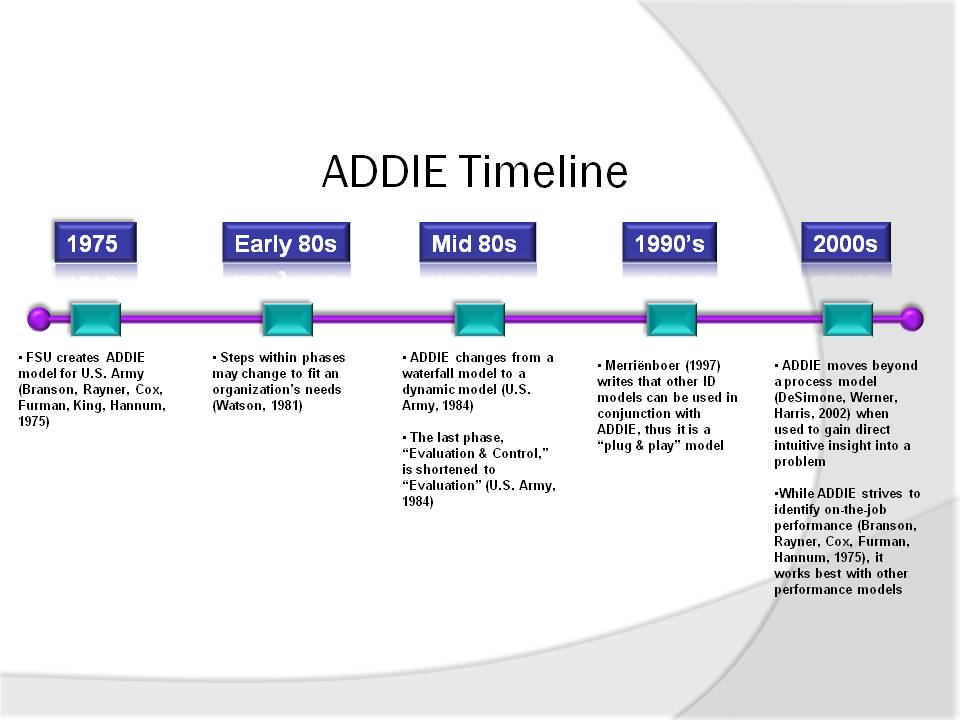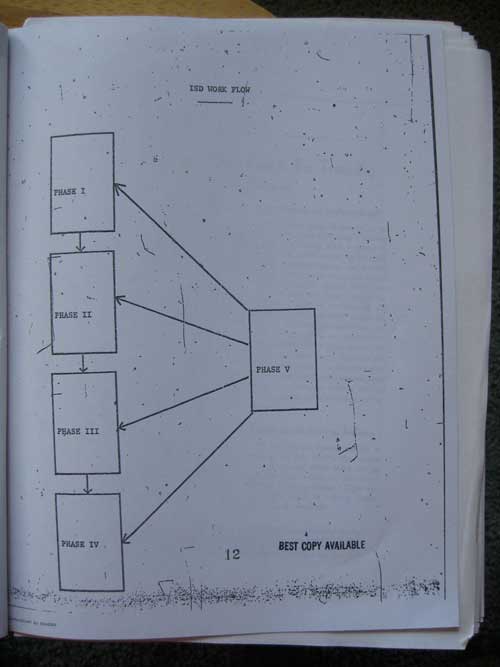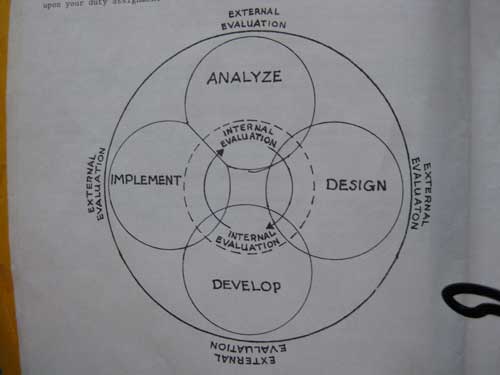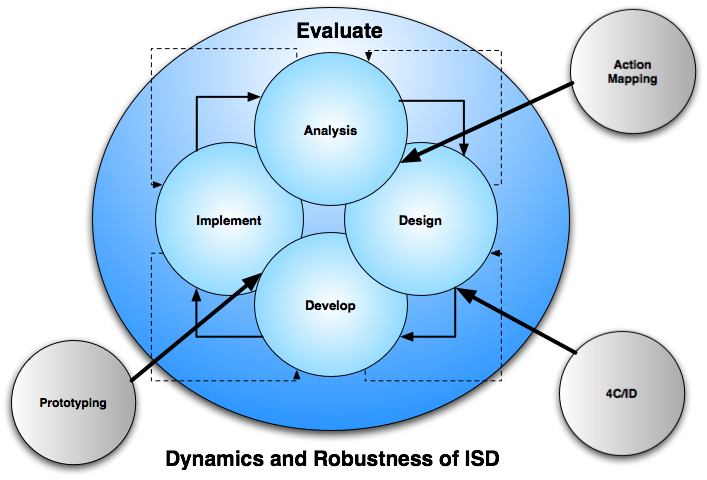


ADDIE (Analysis, Design, Development, Implement, Evaluate) is part of the ISD family (Instructional System Design). It includes such other models as the Dick & Carey (2004) and Kemp (Gustafson, Branch, 1997) models.
While the concept of ISD has been around since the early 1950s, ADDIE first appeared in 1975. It was created by the Center for Educational Technology at Florida State University for the U.S. Armed Forces (Branson, Rayner, Cox, Furman, King, Hannum, 1975; Watson, 1981).
“As defense machinery was becoming more and more sophisticated, the educational background of entry level soldiers was becoming lower and lower. The potential solution to this problem was in the form of a 'systems approach' to training. The system selected for use by the Army was Instructional Systems Development (ISD), developed in 1975 by Florida State University. ISD is a comprehensive five phase process encompassing the entire training/educational environment. Although ISD is a systematic step-by-step approach, it has the flexibility to be used with both individualized and traditional instruction. It is however, specifically orientated towards the use of behavioral/performance objectives and criterion-referenced tests.” - Russell Watson, 1981
Six years later, Dr. Russell Watson (1981), Chief, Staff and Faculty Training Division of the Fort Huachuca, Arizona, presented a paper to International Congress for Individualized Instruction. In it, he discusses the ADDIE model as developed by Florida State University. His presentation contained a chart similar to this:

Note: Watson used a slightly different model than the one developed by Florida State University (shown below) in that the five basic phases are the same, but the steps within each phase have been slightly modified (Branson, Rayner, Cox, Furman, King, Hannum, 1975):

ID (Instruction Design) models differ from ISD models in that ISD models have a broad scope and typically divide the instruction design process into five phases (van Merriënboer, 1997):
ID models are less broad in nature and mostly focus on analysis and design, thus they normally go into much more detail, especially in the design portion. ID models are normally employed in conjunction with ISD models as explained in the section, “Extending ADDIE”.
A model is a simplified abstract view of a complex reality or concept, for example, Silvern defines a model as a “graphic analog representing a real-life situation either as it is or as it should be” (AECT, 1977). This makes ADDIE a model. While it has been pictured in several ways, the model below shows one popular way (Clark, 1995):

ADDIE has often been called a process model (DeSimone, Werner, Harris, 2002); however, this is only true if you blindly follow it. A much better way to use ADDIE is to think of it as a guide for gaining direct intuitive insight into a problem, for example, see the right sidebar, “ADDIE and the 5 Rules of Zen.”
When the ADDIE model first appeared in 1975, it was strictly a linear or waterfall model. For example, in October 1981, Russell Watson presented a paper and wrote, “The five phases of ISD are analysis, design, development, implementation, and evaluation and control. The first four are sequential in nature, but the evaluation and control phase is a continuous process that is conducted in conjunction with all of the others.” He included this diagram with the paper:

However, by 1984 the model evolved into a more dynamic nature for the first four phases. For example, a U.S. Army (1984) training manual reads, “As the model shows, all parts are interrelated. Changes, which occur during one step of the model, affect other steps. In the ISD process, nothing is done in isolation, nor is all done in a linear fashion; activities of various phases may be accomplished concurrently." The manual contains the following model:

The U.S. Army is perhaps one of the most disciplined and structured organizations; however, even they could not design training in such a linear manner, thus they evolved it into a more dynamic nature. Since the original ADDIE model was designed in an university, they took take a summative approach in order to evaluate the validity of the learning/training theory that was to be designed into training. However, Instructional Designers who work in most organizations are far more concerned with actually producing an effective learning learning process to meet the need's of the business, thus they take a more formative approach in order to refine goals and evolve strategies for achieving those goals.
In addition, beside getting to a more dynamic structure, the last phase was changed from “Evaluation & Control to simply “Evaluation.”
The broad scope and heuristic method of ISD has often been criticized by others because it tells learning designers what to do, but not how to do it. Yet it is this broad and sketchy nature of ISD that gives it such great robustness. Merriënboer (1997, p3) writes, “the phases may be listed in a linear order, but in fact are highly interrelated and typically not performed in a linear but in an iterative and cyclic fashion.” He further notes that other ID and learning models can be used in conjunction with ISD.
Thus, ISD basically becomes plug and play — you add other components to it on an as-needed-basis. For example, the ISD model below has Action Mapping, 4C/ID, and Prototyping plugged into it for designing a robust learning environment for training complex skills:

โพสต์เมื่อ 7 ส.ค. 2553 อ่าน 45271 | 0 ความเห็น
·····
·····
 จัดทำเว็บไซต์โดย นายอดิศร ก้อนคำ (ครูโจ้)
จัดทำเว็บไซต์โดย นายอดิศร ก้อนคำ (ครูโจ้)